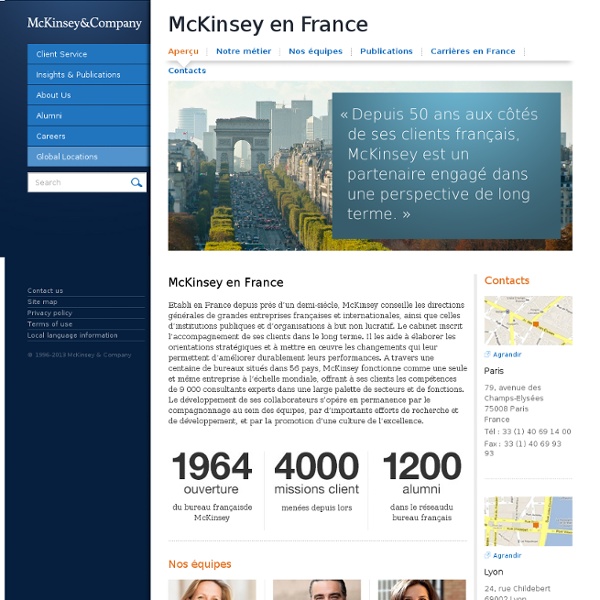



Comment Internet dope l'économie française Un quart de la richesse créée en France en 2010 dépend directement d’Internet. Et un emploi sur quatre créé depuis quinze ans est généré par cette même filière. C’est le résultat d’une étude, en grande partie financée par Google, publiée mercredi par le cabinet McKinsey qui se propose d’évaluer les effets positif d’internet sur notre économie. La filière internet étudiée par les économistes de ce cabinet regroupe les activités de télécommunication voix via l'Internet (VoIP), les activités informatiques (matériel et logiciel) liées à internet, et les activités économiques ayant le web pour support, telles que l'e-commerce ou la publicité en ligne, quelle que soit l'activité des entreprises. Sa contribution directe au produit intérieur brut (PIB) français est évaluée à 60 milliards d’euros en 2009, soit 3,2% du total, et 72 milliards d’euros en 2010, soit 3,7% du PIB annuel. 1,15 million d’emplois La Toile est également un «accélérateur de développement», notamment pour les PME.
Targeting Boosts Low Facebook Click Rates eMarketer estimates marketers around the world will spend $6 billion advertising on social networks this year, and the return on that investment will be a bigger question than ever. Many ad performance metrics have long been low on social networking sites, suggesting internet users simply do not want to click on ads while they’re socializing with friends and family. But how useful are measures of average performance to real-world marketers when so many variables can affect ad performance? According to a widely reported Webtrends study, Facebook ad performance metrics are dismally low—and getting worse. Clickthrough rates for ads targeted to the US were lower than for other countries: Webtrends reported US-targeted ads were clicked on just 0.065% of the time, compared to 0.087% for ads targeted to other countries. A Chitika study compared clicks on Facebook to those on Google and found the social network’s rates were significantly lower.
The Differences Between Mobile and Tablet Advertising Research to date on tablet advertising has typically found that placements that take advantage of the full features of the device—like video, 360-degree views, striking photos and interactivity—appeal most to users. An Adobe-sponsored study found flashy iPad ads were more engaging and effective than their static print counterparts, and earlier research from UM and Time Inc. indicated that videos were the most desired feature of iPad ads. On smartphones, by contrast, users seem to prefer to keep it simple. The Nielsen Company found in August 2010 that 40% of iPhone users were more likely to look at ads with an interesting video, significantly higher than the 15% in the Pontiflex survey. Smartphone users also like ads to keep things simple by leaving them within the app where the ad appeared. The Nielsen study found an identical 71% of iPhone owners had the same preference. iPad owners were somewhat more easygoing; 60% would rather ads did not take them outside an app.
Seniors Slowly Shift to Digital In 2010, seniors ages 65 and older made up 13% of the US population. By 2030, when baby boomers will have aged into the cohort, the US Census Bureau predicts nearly one in five Americans will be seniors—a marketing target that should not be ignored. eMarketer estimates that as of 2011, less than half of this population will be online. “TV, newspapers and radio continue to dominate seniors’ regular media habits,” said Mike Froggatt, eMarketer research analyst and author of the new report “Demographic Profile—Seniors.” Mobile phone penetration is significantly higher, though seniors still prefer landlines: 77% said they were a necessity, vs. 29% who said the same of wireless phones, according to Pew Research Center. Seniors who own cellphones are far less likely than younger age groups to send text messages. Also growing in appeal are social networking sites. “Social networks are gaining traction slowly among older users,” said Froggatt. To purchase the report, click here.
Google Analytics E-Commerce Tracking Pt. 4: Tracking Lead Gen Forms One thing that I try to stress in my client work and training is that Google Analytics is a platform. If you understand the framework you can use it to track many different things. E-commerce tracking is one part of Google Analytics that is particularly flexible and can be used many different ways. There’s a lot you can do with e-commerce tracking even if you’re a non-commerce site. The Need Let’s say we have a lead gen site that sells books, cars and jets (a completely unlikely combination). We want to measure which fields visitors fill out, the values they choose, and the overall value of the form. The Implementation To measure the above I created a simple form using HTML and JavaScript. And here is the source of the above form: When the visitor submits the form the JavaScript code assigns a value to both the item that the visitor chose and their time frame for purchase. In this example a form that includes a high priced item (like a jet) and a short time frame (buy now!) A Reminder